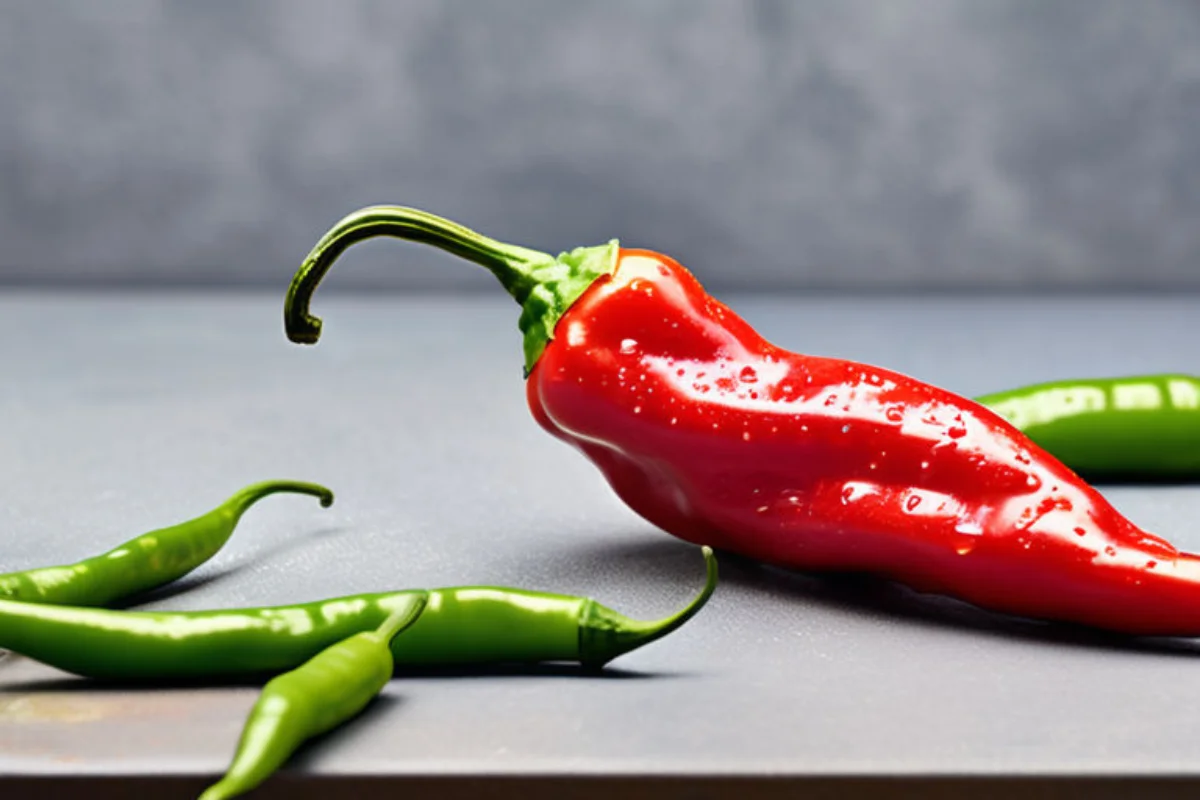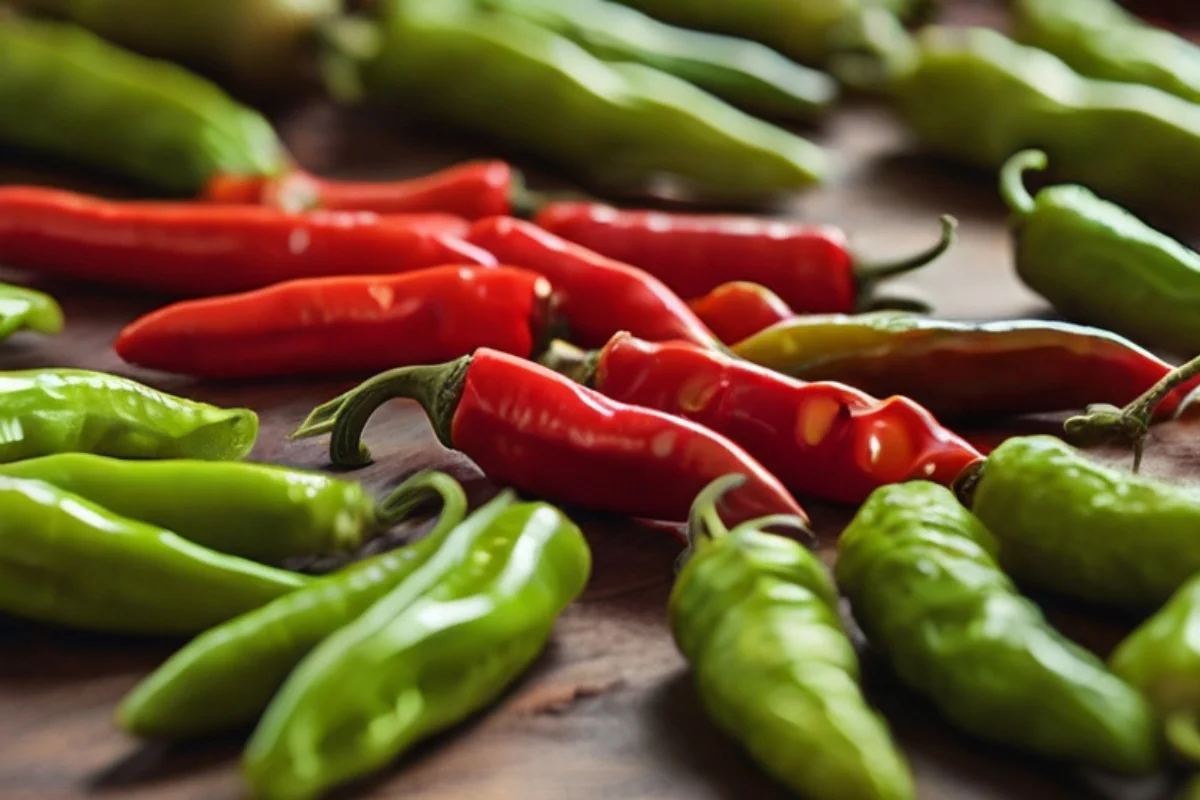Introduction to Pepperoncini Peppers
Introduction
are pepperoncini peppers hot brighten up many dishes. Their unique taste—a blend of mild heat with a tangy twist—makes them a kitchen favorite.
History and Origin
Originating from the sunny regions of Italy and Greece, pepperoncini peppers boast a long heritage. Known also as Tuscan Peppers, they have seasoned Mediterranean cuisines for centuries. Their journey from ancient farms to our tables is a story of culinary migration and innovation.
Popularity and Uses
Now, these peppers enjoy widespread acclaim, far beyond their Mediterranean roots. They spice up American sandwiches and salads and are cherished as pickled delights. Their versatility shines as they add a special kick to salads, sandwiches, and savory dishes, all without overpowering the other flavors.
Pepperoncini peppers, with their mild but distinctive heat, seamlessly integrate into various dishes. As we progress, we’ll explore more about their spiciness, uncover their health perks, and even offer tips for growing them. Our adventure through the spicy and tangy world of pepperoncini peppers is just getting started. Stay tuned for more insights into these tantalizing treats.
Understanding the Heat
What Makes Peppers Hot?
The heat of a pepper, believe it or not, comes from a compound called capsaicin. It’s this compound that tricks our brains into sensing that fiery sensation. Pepperoncini peppers, on the Scoville Heat Scale, register a modest 100 to 500 units. This makes them a milder choice, perfect for those who prefer a gentler warmth in their dishes.
Comparison with Other Peppers
Now, when you pit pepperoncini against other peppers, it’s clear they’re on the milder end of the spectrum. Take, for example, the jalapeño, which can hit up to 8,000 Scoville units, or the habanero, soaring up to 350,000 units. This comparison underscores pepperoncini’s role as a milder, more approachable option for adding just a hint of heat to dishes.
The mildness of pepperoncini peppers makes them incredibly versatile. They’re perfect for adding a subtle zest to a wide array of dishes without overwhelming the other flavors. So, whether you’re spicing up a salad, crafting a sandwich, or simmering a savory dish, pepperoncini peppers offer that perfect balance of heat and flavor. As we continue to explore these delightful peppers, we’ll uncover their culinary uses and discover how they can bring dishes to life with just the right amount of spice. Stay tuned for more savory adventures with pepperoncini peppers!
Culinary Uses of Pepperoncini Peppers
Pickling and Preservation
One of the most cherished methods to enjoy pepperoncini peppers is through pickling. This technique not only preserves their vibrant flavor but also accentuates it, offering a crunchy, spicy garnish to many meals. For those keen on exploring pickling further, consider checking out Annie’s Sweet Amish Pickles Guide, where you can dive deeper into the art of pickling and experiment with different flavors.

Recipes Featuring Pepperoncini
Pepperoncini peppers dazzle in an array of recipes, bringing a unique zing to each dish. Here are two ways to weave them into your cooking endeavors:
- Pepperoncini Pasta Toss: Picture al dente pasta, mixed with sliced pepperoncini, cherry tomatoes, olives, and a splash of olive oil. This dish is a testament to the simplicity and flavor depth pepperoncini can add to a meal. Fans of pasta can expand their culinary horizons with the Ultimate Fusilli Pasta Guide, exploring more pasta varieties and pairing options.
- Greek Salad with a Twist: Enhance the classic Greek salad by introducing sliced pepperoncini to the mix. Their mild heat perfectly complements the creamy feta and crisp veggies, creating a symphony of flavors. For salad aficionados looking to explore more, the Jennifer Aniston Salad: A Blend of Health and Flavor offers another excellent recipe that balances healthfulness and taste.
Nutritional Value and Health Benefits
Nutritional Content
Pepperoncini peppers are a low-calorie option that enriches our diet with essential nutrients. They’re a good source of vitamin C, an antioxidant that supports the immune system and skin health. Additionally, these peppers provide dietary fiber, which aids in digestion and promotes a feeling of fullness, helping with weight management. They also contain vitamin A, calcium, and iron, contributing to overall health and well-being.
Health Benefits
The health benefits of pepperoncini peppers extend beyond their nutritional content:
- Anti-inflammatory Properties: The capsaicin in pepperoncini peppers, though milder than in hotter varieties, can help reduce inflammation and pain, offering relief for conditions like arthritis and headaches.
- Cardiovascular Health: The antioxidants in pepperoncini peppers, especially vitamin C, play a role in preventing heart disease by protecting against oxidative stress and lowering blood pressure.
- Metabolism Boost: Capsaicin has been shown to slightly increase metabolism, aiding in fat loss. While the effect of pepperoncini peppers might be subtle, incorporating them into a balanced diet can contribute to weight management efforts.
Incorporating pepperoncini peppers into your diet not only adds a burst of flavor to your meals but also contributes to your health in multiple ways. Whether enjoyed pickled, tossed in salads, or used to spice up a dish, these peppers offer a combination of taste and wellness benefits that are hard to overlook.
For those interested in exploring more about the health benefits of capsaicin, Healthline provides an insightful read. And for the culinary enthusiasts looking to delve into the art of pickling, Fresh Preserving offers a comprehensive guide to get you started. As we continue to unravel the layers of pepperoncini peppers, remember that their addition to your diet can be as beneficial as it is delicious. Stay tuned for more insights into these fascinating peppers.
Growing and Harvesting Pepperoncini Peppers
Cultivation Tips
Growing pepperoncini peppers starts with a little patience and some sunny space. These peppers thrive in warm, well-drained soil and need a good amount of sunlight to flourish. Start the seeds indoors about eight weeks before the last frost, and transplant them outside when the weather warms up. Space them about 18 inches apart to give each plant room to grow. Remember, pepperoncini peppers love the sun, so find them a spot that basks in its glow for most of the day.

Watering is crucial, especially during dry spells, but be careful not to overwater. Pepperoncini plants prefer a consistent moisture level, so aim for damp, not soggy, soil. As the plants grow, you might find staking helpful to support their stems, especially as the peppers start to mature.
Harvesting and Storage
Pepperoncini peppers usually reach harvest time in late summer to early fall, turning from a bright green to a richer, deeper yellow-green as they mature. When they’re about 2-3 inches long, they’re ready for picking. Gently twist the pepper off the plant or use a pair of scissors to avoid damaging the plant.
Once harvested, you can enjoy pepperoncini fresh, or you might consider pickling them for longer storage. Pickling not only preserves the peppers but also enhances their flavor, making them a versatile ingredient to have on hand. Store your fresh or pickled pepperoncini in the fridge to keep them crisp and delicious.
Growing your own pepperoncini peppers is a rewarding experience that brings a slice of Mediterranean warmth right to your backyard. With a bit of care and attention, you can enjoy these tangy peppers fresh from the vine or as a zesty addition to your meals throughout the year. As our journey through the world of pepperoncini comes to a close, it’s clear that these peppers offer a unique blend of flavor, versatility, and gardening joy.
FAQs
Are Pepperoncini Peppers Good for You?
Absolutely! Pepperoncini peppers are not just about adding a tangy kick to your dishes; they also boast a range of health benefits. Rich in vitamin C, these peppers support immune health and provide antioxidants that help fight free radicals. Additionally, the capsaicin in pepperoncini, although milder compared to hotter peppers, can aid in digestion and enhance metabolic rate. So, incorporating pepperoncini peppers into your diet is a tasty way to contribute to your overall health.
How Do You Reduce the Heat of Pepperoncini Peppers in Dishes?
If you’re sensitive to spice or simply prefer a milder flavor, there are ways to tame the heat of pepperoncini peppers. One method is to remove the seeds and ribs from inside the peppers, as these parts contain the most capsaicin, the compound responsible for the heat. Soaking the peppers in water or vinegar can also help dial down their spiciness, making them more palatable for those who prefer less heat.
Can You Grow Pepperoncini Peppers from the Seeds of Store-Bought Peppers?
Yes, you can grow pepperoncini peppers from the seeds of store-bought peppers, but there’s a catch. Peppers bought from the store may not always produce seeds that are viable or true to the parent plant, especially if the peppers are hybrids. For the best results, purchase seeds from a reputable garden center or online seed supplier. This ensures you’re starting with high-quality seeds that are more likely to germinate and grow into healthy pepperoncini plants.
Pepperoncini peppers, with their mild heat and delightful tang, offer a world of culinary possibilities and gardening adventures. Whether you’re spicing up your meals or exploring the joys of gardening, these peppers provide a versatile and accessible way to add flavor and health benefits to your life. Our journey through the world of pepperoncini peppers may have reached its end, but the exploration of flavors and gardening experiences is just beginning. Happy cooking and gardening!
Conclusion
Summary
From their humble beginnings in the sunny landscapes of Italy and Greece to their celebrated status in kitchens around the globe, pepperoncini peppers have captured the hearts of many. We’ve delved into their history, the secrets behind their mild heat, and their myriad culinary uses, from pickling to adding a punch of flavor to our favorite dishes. Along the way, we’ve uncovered tips for growing these peppers, allowing us to bring a piece of their Mediterranean heritage into our own backyards.
Final Thoughts
Pepperoncini peppers, with their unique blend of tanginess and mild spiciness, stand as a testament to the beauty of culinary diversity. They remind us that food is not just sustenance but an adventure, a bridge between cultures, and a source of joy. As we continue to explore the vast world of flavors, let pepperoncini peppers inspire you to try new recipes, experiment with home gardening, and above all, savor the delicious complexity that each pepper brings to your plate.
In the end, the story of pepperoncini peppers is more than just a tale of a spice. It’s a narrative of culinary exploration, a call to embrace the varied tastes that the world has to offer, and an invitation to make every meal an occasion to celebrate. So, here’s to the next culinary adventure, may it be as flavorful and enriching as our journey with the delightful pepperoncini peppers.
